EcoSport SES ‘deja vu’ is not entirely the same
Filed under: Weekly test drives, Autos
By John Gilbert
Sports is guilty of beating a good phrase into being trite, such as with the great line, “deja vu all over again,” which Yogi Berra once said, but now is used so regularly by baseball broadcasters that it’s doubtful they even realize that it’s redundant. Ironically, it might apply here, this week.
If this review seems redundant, maybe it’s because you just read about the Ford EcoSport about three months ago, but the deja vu is not happening all over again.
I got to test an EcoSport Titanium with front-wheel drive back in April, and now I’ve recently gotten an EcoSport SES with 4-wheel drive. But there is a lot more than just the engine and trim to differentiate the two, so it’s not really a repeat performance.
For this one, I asked my wife, Joan, to take a drive in it just for here always-sought impressions, and she wasn’t kind. “It’s a dog,” said Joan. I suggested she should give it another try, and use the steering-wheels to paddle-shift the 6-speed automatic, while stomping harder on the gas.
She did, and afterward she said: “Still a dog.”
Talk about redundant. I must allow for her to be right, though, and maybe I give small engines the benefit of the doubt for being able to keep up with larger ones in traffic, and overlook such chinks in pedigree. Maybe some of both.
The EcoSport Titanium we drove in April got mixed impressions, but for good reason. As Ford’s smallest utility vehicle, it had surprisingly good acceleration with only a tiny 1.0-liter 3-cylinder engine, thanks to the EcoBoost turbocharger. But, tiny or not, that engine only comes with front-wheel drive, so it seemed silly up in the North Woods when a late snowstorm accentuated that it was front-wheel drive only — no 4×4.
But now we’ve gotten through July, and the last trace of snow is long gone, fried out of our memory by our foray into what we might call Global Warming Sunstroke Season — 90-degree heat in Minnesota — and the EcoSport SES that arrived as a follow-up came with 4-wheel drive. Go figure. I heard a report from Minneapolis, 2 hours south of Duluth, that through July, they had recorded 17 days of 90 or over, usually a rarity.
The EcoSport SES with 4WD costs only a thousand more, at $25,325, than the fancier Titanium 3-cylinder with FWD, which lists for $24,380. But you lose the conversation-piece of the 3-cylinder 1.0, for the more commonplace 2.0, although with the turbo to handle the extra duty of making all four wheels churn.
An interesting aside: The 2.0 turbo’s 160 horsepower leaves behind the 1.0’s little-impact 123 horsepower, but when it comes to torque, the 2.0 has 146 foot-pounds and the little 1.0 a surprising 148 foot-pounds!
Not that the numbers matter. Of more significance is how it feels, which is where Joan’s assessment might sting. The EcoSport looks to me like a subcompact sedan, but it is classified as an SUV, or more accurately a CUV (crossover utility vehicle). So if you’re going to make and sell me an SUV or CUV in Duluth, Minnesota, make sure it’s a 4-wheel-drive model, OK?
Granted, a good FWD vehicle with the best winter tires (Nokian, anyone?) can go anywhere in any blizzard, but all things equal, you get more efficient blizzard-beating with 4WD or AWD, or whatever you choose to call it on any particular vehicle. To say nothing of the peace of mind feeling that comes along when a blizzard hits and you know you can barge through it.
Frankly, I do appreciate the EcoSport’s utility. It has surprising room for something that looks so stubby — aerodynamic, yes, but still stubby — to have so much available room to haul a couple other adults in the rear seat and to stow groceries or luggage in the way-back, inside the hatch.
Ah, the hatch. When is a hatch not a hatchback? When it’s an EcoSport SES with a side-opening rear door. Maybe Ford wanted to cater to the reputation of U.S. buyers to not want a hatchback, but this one is hinged on the left side, with the door handle on the right, and then look out, because you have to step back to avoid the wide-swinging door.
As a comparatively tall vehicle, there is plenty of headroom, even with the large sunroof, and the stowage might be misleading if they count cubic feet all the way to that high ceiling. There also is plenty of room for housing all the latest connectivity SYNC features, and safety stuff to alert you to blind-spot intruders and to help avoid backing into cross-traffic.
I was disappointed with the fuel economy, which is estimated at 14 city and 36 highway, but I found it unlikely to get it up to 30 in my driving. I also didn’t find the little 3-cylinder approached its EPA estimates, and getting a mini-sized SUV with a tiny engine should at least assure you of lofty mileage.
The sport-tuned suspension in the SES version of the EcoSport does make it handle in a nice, flat, firm attitude around curves or tight corners, and the larger 2.0 4-cylinder has a chance to shine. But you’d be wise to hit the left paddle a couple times and drop down to third or even second if you want anything resembling spunk to be delivered from your little gem.
If you don’t, you won’t have anything at all to stand on as evidence to debate your wife when she suggests the vehicle should be required to wear a collar with a name-tag.
New Compass pays tribute to fallen FCA leader
Filed under: Weekly test drives, Autos
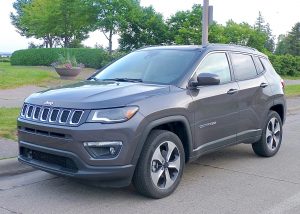
Jeep’s new Compass is truly a global exercise, with an engine of South Korean, Italian and U.S. heritage.
By John Gilbert
While driving a 2018 Jeep Compass for a week in Northern Minnesota recently, I quietly inscribed another chapter in the ongoing refinement of the Jeep family into my memory bank.
This time, it was as a tribute to Sergio Marchione, the automotive executive of the year for any year, or every year. Marchione died unexpectedly two weeks ago, far too young at age 66. A thoroughly engaging personality brimming with charisma, Marchione had pulled off a creative deal to take over Fiat and the bankrupt Chrysler Corporation by merging them together into FCA — Fiat-Chrysler Automobiles.
That was in 2009, and he met a couple of legal challenges to gain full control of Chrysler without spending anything. He then separated Dodge trucks into Ram, separate from Chrysler-Dodge cars, where Jeep had always been. Resolutely, he guided Ram and Jeep into being the No. 1 and 2 profit-makers for FCA, lifting both Chrysler Corporation and Fiat out of the red in less than a decade.
In the process, the renamed FCA steadily improved and refined both Ram and Jeep models, adding new models from both Fiat and Chrysler, while upgrading all the cars in the organization. I had the chance to talk to Marchione on a couple of occasions, and found him refreshingly direct, candid, and willing to answer any and all questions. The introduction of the Alfa Romeo Giulia and companion Stelvio SUV a year ago was a huge plus for the corporation. Driving the new Ram pickup proves it to be possibly the most refined pickup in the industry.
On the Jeep side, renovations of the entire line included an all new compact Renegade, and a companion Fiat 500X, plus an all-new Cherokee, and, a year ago, an all-new Compass.
Then suddenly, the alarming news came that Marchione had gone to a hospital in Zurich, Switzerland, for “shoulder surgery” and that he would not be able to return to work as FCA’s CEO. Then, suddenly again, the news came that he had died. Indications are that he had mostly kept secret that his shoulder surgery was to treat a soft-tissue sarcoma, an invasive type of cancer in his right shoulder. During the surgery, Marchione suffered an embolism — a blood clot — that caused him to fall into a coma. He never came out of it.
All of that sad news has put FCA into some sort of a spin, with questions about the company’s future coming from everywhere. And it is into that climate that I got a Compass delivered to me for a week-long test.
Jeeps always are fun to drive, especially if you have an area where you can do some serious off-road driving. Not necessarily rock climbing stuff, but just taking on remote woodland trails and terrain, where you’d never venture in a normal car. I guess that’s part of it: Jeeps are not normal.
Decades ago, I really didn’t like Jeeps, and wondered why those who did, did. They were rattly, suffered from frequent maintenance issues, and even when new seemed on the verge of starting to show off their lack of refinement. Then they came up with the Cherokee, which was the first Jeep I really admired. Oh, you have to admire the Wrangler, which seemed proud to show off its World War II heritage, but only off-road.
The Cherokee came in under the Wagoneer, a large and very undependable creature that could nuisance you to the point of distraction even in a week’s time. I’ve previously relayed the story of a Grand Wagoneer I was testing in mid winter and my wife and I drove to a high school hockey game and parked about a block from the arena in Minneapolis. After the game, we were walking back and I heard a car horn honking, constantly, without interruption. I mentioned to Joan how some poor so and so had his horn stuck on a 10-below zero night. We turned the corner, and it was our Wagoneer test vehicle, its horn blaring loudly. We pulled the wires to stop it, then found the battery was dead and we had to get a jump start. Afterward, I reconnected the horn wires and found it wouldn’t honk when I hit the horn, but it would honk every time I turned left!
Anyhow, the Cherokee grew into the Grand Cherokee, to make room for a smaller Cherokee, then came the rest of the family, including the Patriot, Compass, and assorted other vehicles of varying sizes.
The new Cherokee comes with three engine choices, one of which is a new 2.0-liter turbocharged 4, which is the result of a green-lighted bold move by Chrysler engineers to develop a new small engine on American soil — one of the qualifications for his Fiat operation to gain full rights to Chrysler.
The Compass, meanwhile, stands in testimony to where Jeep specifically and FCA in general have gotten under Marchione’s fine and forceful hand. Not only is the body shape and design pleasing, the interior is vastly improved, and it is now a fine place for a driver or passengers.
But the perfect example of FCA is under the hood. Read more
VW Atlas and the quest for blueberry pie
Filed under: Weekly test drives, Autos
By John Gilbert
Where will it all end, this apparent runaway escalation in number and size of Sport-Utility Vehicles? For Volkswagen, the end is here in the form of the large, and extremely spacious Atlas.
I’m on the record as being in favor of the smallest vehicle that is big enough, but our test drive timing was perfect, because we were taking four adults to find the perfect piece of blueberry pie. We needed the room, because we were embarking on a nearly 2-hour trip to Ely, Up North on the edge of the Boundary Waters Canoe Area Wilderness, where it was Blueberry Festival time.
The Atlas is the largest vehicle Volkswagen has ever built, and it is a new dimension from a company that made its impact by building compact, fuel-efficient and fun cars, such as the Beetle, Golf, former Rabbit, Jetta, and on up to the larger Passat and longer Sportwagon.
We loaded up a new Atlas with four adults, my camera bag, spare hiking shoes, a windbreaker/rain jacket each, just in case, and a cooler full of sparkling Perrier and iced tea, and we headed off with a half-dozen CDs in the console for our second trip in a couple weeks from Duluth to Ely.
There’s something about Minnesota blueberries in the middle of summer. They thrive, while they struggle in some other areas of the country. Up North, you find two varieties of blueberries — the large, marble sized prizes raised carefully by nurturing gardeners, and the little tiny blueberries growing wild in the woods. There is no question the tiny ones have unexcelled intensity in their flavor, but you have to spend a lot of time down low to the ground to find the beds where they flourish.
In any case, the various places that make and sell fresh blueberry pies could charge anything they wanted for a slice of those delicacies. And even though the Chocolate Moose restaurant has closed, we wanted to go right up to the large weekend festival that fills Ely’s city park with all sorts of handiwork. When we first walked in to the crowded square block site, we spotted the facility that sold various light foods and also proclaimed boldly: “Blueberry Pie.”
We were patient, leaving the best for last. It was a hot day, but we could wander around the many displays and hold off on satisfying our quest. We did hit the kettle-corn stand for a large sack of their specialty, and when we heard some fine harmony from a nearby stage, we wandered over and were thoroughly entertained by Pat Surface with the Boundary Water Boys, performing a series of folk-country classics.
On the way up, we appreciated the way the Atlas handled the many twisting curves and hills through the towering pine trees in and around the numerous lakes and rivers. It is one of the most fun highways in the country, driven moderately, of course. The Atlas comes in base form with VW’s long-proven 2.0-liter, 4-cylinder turbo, while our SEL had the optional 3.6-liter V6 with 276 horsepower and 266 foot-pounds of torque, with plenty of punch to handle those curves. Read more
Land Rover fans can enjoy new Discovery
Filed under: Weekly test drives, Autos

Land Rover’s 2018 Discovery HSE visited Grand Marais, Minnesota, powered by a smooth, silent 3.0 V6 turbocharged diesel with 443 foot-pounds of torque.
By John Gilbert
Land Rover has built all manner of luxury off-road vehicles for decades, and the company’s recent success has allowed it to establish a full-range of vehicles — all of them tough, over-achievers, all of them expensive, but filling every niche SUV buyers might be looking for.
If I had to pick one, it would be tough. There is no such thing as a Land Rover that is not enjoyable to drive or to ride in. I might take the new Velar, for its sleek styling that is remindful of the Evoque, which is low-slung and sporty.
My latest attraction, however, is the Land Rover Discovery, and it is a mind-blower for all sorts of impressive reasons. It was brought back into the U.S. market a year ago as a replacement for the LR4, the recently discontinued base entry. The Discovery no longer is the basic, bargain-priced Land Rover.
I actually drove the Discovery a couple of times before I checked out the fact sheet and learned it was a turbo-diesel. It was so quiet as to be nearly silent, but its power came on with a steady rush. Shifting was smooth all the way up, and the suspension settings kept it poised and firm in any and all cornering ventures. We drove from Duluth to Grand Marais and back one afternoon, with two adults comfortably in the rear seats. Read more
Wild Mustang GT still around, eager to be tamed
Filed under: Weekly test drives, Autos
By John Gilbert
Back about 1970, the Trans-American series, or Trans-Am, was a premier road-racing series, for the suddenly popular “ponycars” like Mustang, Camaro, Challenger, Barracuda, Firebird and later the AMC Javelin.
Mark Donohue in the Roger Penske Camaro was hard to beat, but the most colorful team was the Bud Moore Mustangs led by the inimitable Parnelli Jones. Driving the No. 15 Mustang painted a uniquely bright yellow-orange, Jones won the 1970 championship and always ran up front, referring to his own race car as being “school-bus orange.” Even though it was more yellow-orange, the nickname was as good as the fact.
While the other ponycars disappeared in a changing society gravitating toward larger and smaller cars, the Mustang ensued, coming out in various shapes and sizes, some of which now seem odd in retrospect, as Ford has recreated the Mustang in the image of those 1970-era cars. So has Dodge, with Challenger, and Chevrolet, with Camaro.
They are all captivating, in a future-retro sort of a way, but to me, the Mustang is the most refined, maybe even near perfect for recapturing that era.
A few months ago, Ford announced that it may eliminate production of nearly all its cars in favor of the newly popular and various SUVs. People throughout the country and industry were shocked, and Ford followed by announcing the only cars it would keep producing were the Mustang and the Focus. No more Taurus or Fusion, or Fiesta, which seems startling.
But as long as the the Mustang continues, all is OK.
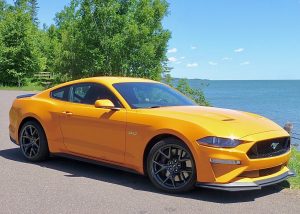
Familiar look, rock-firm platform, and 460-horsepower V8 with a 6-speed stick is Mustang GT identification.
I’ve driven some model of every Mustang ever made, and I owned a 1970 Boss 302 for over 20 years, which I believe was the best road-racing-ready production car ever. It had gone through various modifications and alterations before I sold it to a guy who wanted to restore it to original form. Among the reasons I relinquished it was because the newest generation Mustangs had become so high-tech they could compete, in my mind, with all that was great about the Boss 302.
Right after the Fourth of July, a new 2018 Ford Mustang GT arrived inmy driveway in
Duluth, Minnesota, and it showed upfor me to live with for a week. It practically glowed in an amazing metallic yellow-orange that immediately struck me as a close proximity to “school-bus orange.”
It was thoroughly enjoyable to drive, if not to ride in as a passenger. My wife, Joan, put up with it for about 5 miles of Duluth-area, obstacle-course passenger-seat riding before she announced she was less than anxious to ride in it any more — Recaro bucket seats or not.
The finely-tuned suspension has toggle-switch dash settings to adjust from normal to sport, to track, to dragstrip, to special competition, and each alteration goes from firm to firmer, and the steering stiffens noticeably. As a driver, you love it; as a passenger, it gets pretty tiresome.
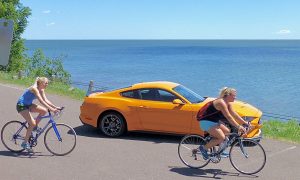
Bike-riding cousins relived Duluth college days by revisiting Hwy. 61 and cruised by for a closer look along the North Shore.
The thrill that conquers all such nitpicks, however, is the unbelievable sound that goes right from your shoe soles to your body’s soul in about one-tenth of a second. It is a spine-tingling rumble, reverberating through the neighborhood. Not really that obtrusive to your neighbors, but absolute music to your ears.
Climb in, adjust the seat, and the steering wheel, put the clutch to the floor and hit the starter button. Give it a second to let that great sound engulf you and the interior of the car, and blip the throttle a couple times if it’s not up to your standards.
Let out the clutch, gently, and try to do it smoothly enough to launch without a neck-snapping jerk or two. The big, wide rear tires grip like race tires — on dry pavement, at least — and they stick with precision in the tightest cornering, while the hyper-tuned suspension holds the car’s attitude in place.
Again, though, we go back to that engine, a 5.0-liter V8 which smoothes out from raw to low-rev power to a smoother roar as the RPMs built. Shift the slick 6-speed stick into second, then third, and you have swiftly attained any legal speed limit on any road in the country. With three gears to go.
The 5.0-liter V8 has been tweaked and refined to deliver 460 horsepower and 420 foot-pounds of torque, perfectly regulated with that 6-speed and judicioius throttle control.
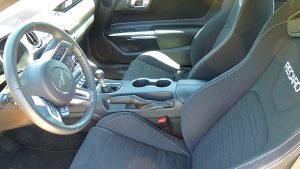
Recaro bucket seats, toggle-switch controls, racing steering wheel, and high-tech connectivity fill the Mustang GT interior.
There are still even more potent Mustang models available for more money, with superchargers and all, but the GT stands out as a true bargain in the industry, with a base GT price of $35,190. Of course, you can start adding on satellite radio, navigation and all kinds of options, and run the price easily over $40,000, but the base car is well-equipped as is.
The neat and efficient interior of the test car had all the latest electronic-gizmo features of the contemporary car world, and that includes the taught suspension-tire combination and the quick steering. It also adds traction control, and a much appreciated hill-start feature that isn’t new in the industry anymore, but is great on a steep incline when you have to make sure of your touch on the clutch as you launch. The car sits motionless as you release the clutch, a welcome aid.
I found the width of the front tires was such that you need to pay extra attention on tight turns because the width and grip almost cause the car to jerk free of your hold on the wheel, as if it wants to steer itself. Like a wild horse of its own name, it wants to take the bit in its mouth. So be ready to manhandle the steering wheel just a bit to maintain your authority.
While the driving is an exciting venture at any and all speeds, and in any and every gear, the sound, and the almost-glow-in-the-dark color make the Mustang GT a cinch attention-grabber, for passers-by, pedestrians, and, yes, officers of the law.
The front end of the Mustang GT has a ferocious look to it, with the spoiler hanging down so low you’ll also want to be extra careful how close you get to parking lot divider curbs. The large mouth of the grille is impressive, especially when flanked by the slick, and sleek, LED headlights and their enclosure.
The silhouette is pure Mustang, and not the blocky 1966 original, but the sleek fastback of the 1969 and 70 road-racing Mustangs. It looks aerodynamically slippery, and you are surprised that there is something close to adequate rear-seat headroom under the steeply sloping roof. Even more surprising is the trunk, which opens to a large-capacity cavern that will house a lot of stuff when you hit the road. And hitting the road will be a temptation you will find difficult to resist with the Mustang GT.
Ford engineers have done great work with their engines in recent years, from the EcoBoost V6 and 4s which can mimic larger engines with their turbocharged efficiency. But they have not overlooked the 5.0 V8, obvioiusly. This engine is the mainstay of the F150 pickup line, unless you go for the EcoBoost, but it feels as it belongs to the Mustang.
With all the new, high-tech vehicles coming out, in sedans, compacts, SUVs and pickup trucks, there is so much to evaluate and test that I must admit I was not desperate to get my hands on the new, 2018 Mustang, even though I knew it had been redone with revised styling, and that the old and tired standard V6 had been dropped.
Once it showed up, with its charcoal-grey spokey wheels on the low-profile tires, and that stunning paint job — which shows off its millions of metallic grains only when you get close and check it in bright sunlight — only then did I realize how glad I was that I had been chosen to spend a week with the new Mustang GT.
Then I started the engine, blipped the throttle, and considered what might happen if I headed deeper into the North woods just to see how long it would take Ford to find me.


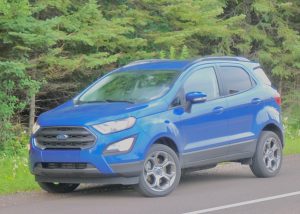
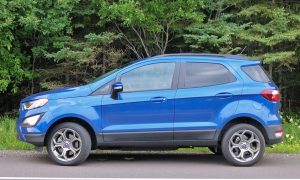
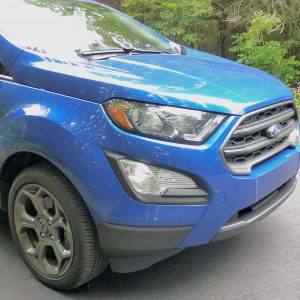
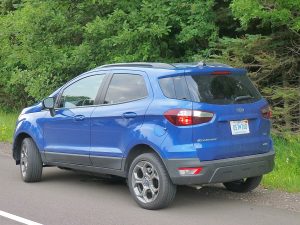
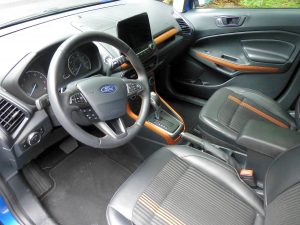
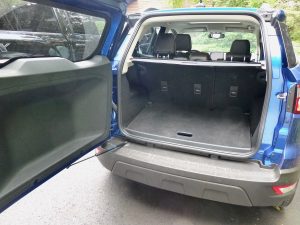

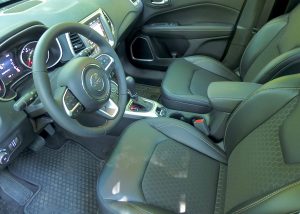
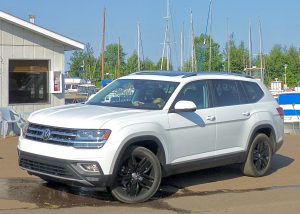
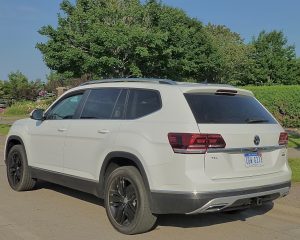
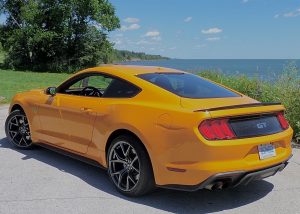
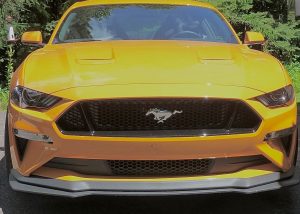
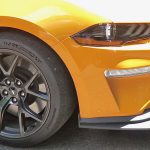
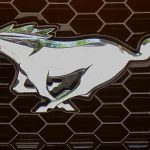
 John Gilbert is a lifetime Minnesotan and career journalist, specializing in cars and sports during and since spending 30 years at the Minneapolis Tribune, now the Star Tribune. More recently, he has continued translating the high-tech world of autos and sharing his passionate insights as a freelance writer/photographer/broadcaster. A member of the prestigious North American Car and Truck of the Year jury since 1993. John can be heard Monday-Friday from 9-11am on 610 KDAL(www.kdal610.com) on the "John Gilbert Show," and writes a column in the Duluth Reader.
John Gilbert is a lifetime Minnesotan and career journalist, specializing in cars and sports during and since spending 30 years at the Minneapolis Tribune, now the Star Tribune. More recently, he has continued translating the high-tech world of autos and sharing his passionate insights as a freelance writer/photographer/broadcaster. A member of the prestigious North American Car and Truck of the Year jury since 1993. John can be heard Monday-Friday from 9-11am on 610 KDAL(www.kdal610.com) on the "John Gilbert Show," and writes a column in the Duluth Reader.